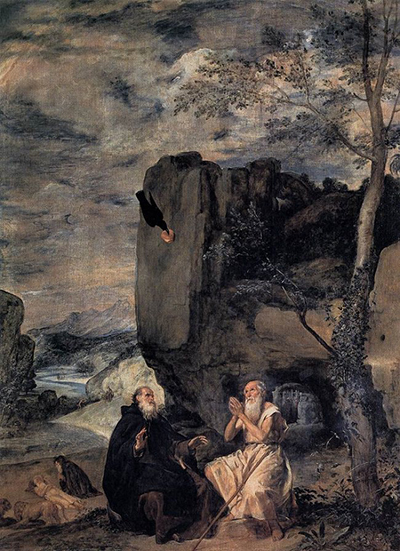Diego Velazquez again touches on religious themes within this painting, titled St Anthony Abbot and St Paul the Hermit. The piece is dated at circa 1634.
The scene found here captures Saint Anthony the Abbot's trip to Egypt where he would meet up with Saint Paul. Saint Anthony's journey is described by him being featured several times within this same painting. He sports a black cape with brown undergarment and we see him appearing several times as our focus drifts further into the background. In a cream coloured robe is the Christian hermit of the 4th century who prays to the skies in the foreground of this piece. In another scene to our left, we see that the Saint has passed away, as two lions help out to dig his grave. This is a good example of how Velazquez's paintings would continue to excite you with new details appearing after your first gaze. He was inventive and unconventional in this way.
Compositionally, many have drawn a comparison with St Francis in Ecstasy by Italian artist, Giovanni Bellini, who himself would regularly feature elements of landscape art within his work. We also known that Velazquez's version was actually based on an engraving by Albrecht Durer, which would have been from the 16th century. Additionally, there was also a Sánchez Coello painting again on the same topic which must have come to his attention prior to commencing this piece. As one can see, religious themes were re-used again and again during this period in European art history, partly because of the demand for them from wealthy patrons, but also because of the emotive and exciting images that they delivered through these various passages of scripture. As a well travelled and educated man, comparisons can often be suggested for Velazquez as to what might have inspired each of his paintings, but there was also a lot of creativity and innovation within his career that should never be forgotten.
This painting is now a part of the prestigious collection of the Prado Museum in Madrid, Spain. They represent Spanish art better than perhaps any other institution in the world and also feature a number of other Velazquez paintings, such as View of the Gardens of the Villa Medici, Rome, with a Statue of Ariadne, View of the Gardens of the Villa Medici, Rome and also Francisco Pacheco. There is much more besides to find here, with a focus on famous art between the periods of the early Renaissance up to around the 19th century. Aside from Velazquez, they host a number of major individual highlights, as well as deep summaries of several notable artists, including Hieronymus Bosch, Joaquin Sorolla and also El Greco. In all honesty, one could easily spend an entire week within Madrid looking at art, once you consider some of the other contemporary galleries also found fairly close to the Prado Museum.




